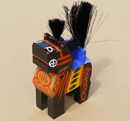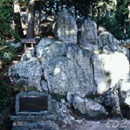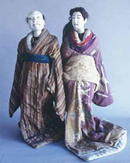
Course 1 Koriyama Area
- Nishida-machi Takashiba Deco Houses (sightseeing/ Miharukoma experience)
- Tenjin Meoto Cherry Tree
- Pegmatite Stones
- Hiwada Takakura Doll museum
- JAKOTSU JIZODO
- Asaka Park (break)
- Oshu Tree-lined Highway
- Nishida-machi Takashiba Deco Houses (sightseeing/ Miharukoma experience)
- Deco Mansion is the nationally famous home of toymaking, with four houses maintaining a centuries-old tradition of making papier-mache dolls and masks.To this day the tradition of the Miharukoma special wooden doll molds has been passed on and has become an important cultural item in Fukushima prefecture.
Time needed: 2 hours

5 minutes on foot
- Tenjin Meoto Cherry Tree
- This 500-year old flowering cherry tree is located near the Deco Mansion Takashiba.
Time needed: about 20 minutes

20 minutes by car
- Pegmatite Stones
- The area of Kashima Shrine has so many of these large white granite pegmatite rocks all over that it has been designated a natural monument. It is estimated that there are over 14,000 tons of such stones.
Time needed: 1 hour

30 minutes by car
- Hiwada Takakura Doll museum
- During the Edo Period, the art of ningyo joruri puppetry flourished in the Kansai and Shikoku area as it did in Asaka-gun, Yamanoi Village, Takakura (now Hiwada-machi Takakura). We are not sure of the origin, but this appears to be the northernmost limit of the distribution of the national puppet show. At the end of the Meiji era, the practice of this puppet show also came to an end, and the puppets were put in baskets and stored at Sansei Temple and finally on display now at the Hiwada Community Center
Time needed: about 1 hour

3 minutes by car
- JAKOTSU JIZODO
- Constructed in late Edo style, the Buddhist structure enshrines a Jizo statue made partly from snake bones. Legend (and the “Princess Sayo Story”) has it that long ago the deceased princess became the spirit of a snake and once a year the snake came and sacrifices were made to the snake Spirit. Behind the building is are sculptures of 33 Kannon respecting those who were sacrificed. Today we can still see snake holes and their resting rocks, and historic sites relating to this legend in the area. The hall was designated a City Cultural Heritage in 2000.
Time needed: 10 minutes

3 minutes by car
- Asaka Park (break)
- Following the pine trees of the old highway north of Oshu Hiwada, we come to a small hill, Mt. Asaka. It is said that the poet Matsuo Basho came here. Now it is a nature park famous for cherry blossoms and azaleas.

10 minutes by car
- Oshu Tree-lined Highway
- In search of the legendary “hana katsumi” flower, the poet Basho is said to have walked this tree-lined stretch of the Oshu Kaido, from Hiwada to Fukuyama. Oshu Kaido was one of Edo’s five famous highways, and today we can walk part of it for about 45 minutes.
COURSE 2 Koriyama Area
- Hiking on Mt. Uzumine/Shimizu Well
- Cliff of the 33 Kannon
- Tamura Shrine
- Egawa Ezo Burial Caves
- Oyasuba Historic Ruins Park
- Daizen Shrine Wysteria
- Hiking on Mt. Uzumine/Shimizu Well
- Rising 677 meters above sea level, Mt. Uzumine has become a popular hiking course for families. Near the top of the mountain the Yatagawa Course offers fresh water springs. From the top, you have a spectacular view of the Abukuma mountains overlooking Koriyama, and farther in the distance Nasu, Bandai, and Adatara. Like the old warlords who slaked their thirst here in the past, you can wet your whistle before you continue your climbing.
Time needed: about 1 hr. 30 min.

15 minutes by car
- Cliff of the 33 Kannon
- Iconography and characters have been carved into the natural rock here, and a sculptures of the 33 Kannon. This was done during the Meiji Era as a compilation of “Local history of Tamura” because a plague visited the village of Otomo in 1773, and prayers were carved in for the souls of the dead, and for the health and safety of villagers and visitors past and present.
Time needed: 15 minutes

5 minutes by car
- Tamura Shrine
- Along what is now National Highway 49 we find Tamura-machi Moriyama and the shrine founded in Daido era. The large main hall and the enclosed altar with doors are important cultural assets of Fukushima Prefecture. The atmosphere here is most impressive, with cherry blossoms brightening the solemn space in the springtime.
Time needed: 1 hour

10 minutes by car
- Egawa Ezo Burial Caves
- This is a cliff grave of the Kofun Period (7th c.) The cavities were dug for burial and one contained a beautiful sword as a decoration. Thirteen such burial caves have been found.
Time needed: 15 minutes

5 minutes by car.
- Oyasuba Historic Ruins Park
- The park was created to give an experience of the burial sites of the Kofun period in Tohoku.

3 minutes by car
- Daizen Shrine Wysteria
- This Inari shrine a little east of Highway 49 and near Daianjo Kofun Park boasts a profusion of wisteria. Here and there the lofty trees are spotted with the hanging masses of pale purple flowers.
COURSE 3 Koriyama Area
- Sukagawa Peony Garden
- Basho Memorial Museum
- Midori-ga-Oka Park
- Shakado River
- Sukagawa Peony Garden
- 7000 plantings of 290 varieties of peonies bloom in a ten-hectare park three times the size of Tokyo Dome. The best time to see the peony blooms is from late April to mid-May. A statue of a peony Princess stands in front as a sign of lasting exchanges between Sukagawa and friendship city, Luoyang, China.
Time needed: 30 minutes

15 minutes by car
- Basho Memorial Museum
- In Genroku 2 (1689) the famous poet Basho stayed for eight days and seven nights in Sukagawa and wrote his haiku “The Depths of the Narrow Road”. In 1989 the memorial was built to the right of the current City Hall entrance. Hachiman Shrine has greeted visitors and worshippers for three hundred years since that time. It has been used as a center for many cultural activities as well as tourist information.
Time needed: 30 minutes

About 3 minutes by car
- Midori-ga-Oka Park
- In July of 1989 this park was chosen as one of the 100 best urban parks in Japan and in February of the next year, “Fukushima Prefecture Hometown Amenity". At 29.9 hectares, about seven times the size of Tokyo Dome, the park includes the lawn, Freedom Square, a free space for children to play, a waterfall and monumant with Manyo poems inscribed on 60 monuments. In addition there are museums and sports places and rest spots in a complete park. Inside the park flows the Suka River flows through the park too, and for one kilometer people can enjoy reflections of the row of 196 cherry trees that line it.

10 minutes by car
- Shakado River
- Spring brings tulips and cherry blossoms; summer brings salvia and marigold, fall cosmos and winter snow flowers. All four seasons compete for the beauty prize and citizens come to the river to enjoy this meeting of flora and aqua. It is also a great spot for health and fitness exercise, with jogging and cycling paths.
Time needed: 15 minutes
↑go to top

 5 minutes on foot
5 minutes on foot
 20 minutes by car
20 minutes by car
 30 minutes by car
30 minutes by car
 3 minutes by car
3 minutes by car
 3 minutes by car
3 minutes by car
 10 minutes by car
10 minutes by car

 15 minutes by car
15 minutes by car
 5 minutes by car
5 minutes by car
 10 minutes by car
10 minutes by car
 5 minutes by car.
5 minutes by car.
 3 minutes by car
3 minutes by car

 15 minutes by car
15 minutes by car
 About 3 minutes by car
About 3 minutes by car
 10 minutes by car
10 minutes by car

 Japanese
Japanese English
English










